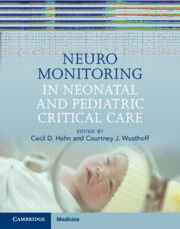Book contents
- Neuromonitoring in Neonatal and Pediatric Critical Care
- Reviews
- Neuromonitoring in Neonatal and Pediatric Critical Care
- Copyright page
- Contents
- Contributors
- Acknowledgements
- Part I General Considerations in Neuromonitoring
- Part II Practice of Neuromonitoring: Neonatal Intensive Care Unit
- Part III Practice of Neuromonitoring: Pediatric Intensive Care Unit
- Chapter 10 Management of Status Epilepticus and Recurrent Seizures
- Chapter 11 Screening for Seizures in At-Risk Pediatric Patients
- Chapter 12 Monitoring for Impending Ischemia
- Part IV Practice of Neuromonitoring: Cardiac Intensive Care Unit
- Part V Cases
- Index
- References
Chapter 12 - Monitoring for Impending Ischemia
from Part III - Practice of Neuromonitoring: Pediatric Intensive Care Unit
Published online by Cambridge University Press: 08 September 2022
- Neuromonitoring in Neonatal and Pediatric Critical Care
- Reviews
- Neuromonitoring in Neonatal and Pediatric Critical Care
- Copyright page
- Contents
- Contributors
- Acknowledgements
- Part I General Considerations in Neuromonitoring
- Part II Practice of Neuromonitoring: Neonatal Intensive Care Unit
- Part III Practice of Neuromonitoring: Pediatric Intensive Care Unit
- Chapter 10 Management of Status Epilepticus and Recurrent Seizures
- Chapter 11 Screening for Seizures in At-Risk Pediatric Patients
- Chapter 12 Monitoring for Impending Ischemia
- Part IV Practice of Neuromonitoring: Cardiac Intensive Care Unit
- Part V Cases
- Index
- References
Summary
The use of electrophysiological methods to monitor patients for cerebral ischemia is based on the observation that electrical brain activity is exquisitely dependent on adequate cerebral perfusion. The effect of ischemia on the EEG is dependent on the degree, duration, and rate of hypoperfusion, as well as on the cerebral metabolic rate, which itself can be influenced by sedation and body temperature. EEG can serve as an early indicator of ischemia, before clinical signs may be apparent and potentially before permanent injury occurs. Visual interpretation can be assisted by quantitative EEG analysis (QEEG). This chapter details the use of neuromonitoring for the detection of ischemia.
- Type
- Chapter
- Information
- Neuromonitoring in Neonatal and Pediatric Critical Care , pp. 157 - 164Publisher: Cambridge University PressPrint publication year: 2022

